Do you have a favorite method of managing learning centers in preschool?
I’ve been involved in early childhood education for over ten years now. Over the years, my opinions on center management have changed a bit. Have you seen a transformation in your thoughts on this topic, too?
When I taught kindergarten, I used both free choice and structured center management, depending on the class and the time of year. I’ve used both methods with many of my preschool classes, as well.
I’ve always made it a point to provide my students with open-ended activities and the ability to choose learning activities . . . no matter the center management technique. While I believe that both free choice and more structured methods work well, I now think that free choice learning centers in preschool are the way to go.
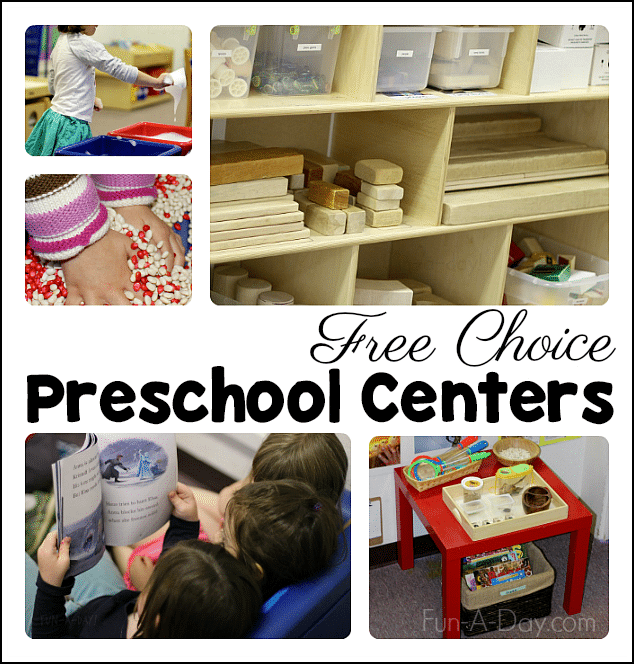
Related: Preschool Centers Guide with Center Signs
What are Free Choice Learning Centers in Preschool?
Free choice centers mean students can choose from any available centers. You, the teacher, control which centers are available. You’re also responsible for the materials available at each center and how the centers are physically arranged. But you’re not making every decision about where the kiddos go during center time.
In addition to deciding which centers to go to, students are also allowed to determine how much time they spend within each center. For example, one child might stay at the building center the entire center time. Another child might go to the reading center for 10 minutes, the home center for 30 minutes, and the writing center for the rest of the time.
What are the Benefits of Free Choice Centers?
First and foremost, the children are allowed to make their own decisions. It might seem pretty basic to us, as adults, but it’s incredibly important to the kids. It gives them more ownership over their learning experiences.
On top of that, students are able to focus on what interests them most. My center time goals are twofold – it’s a way for me to work with individual children and small groups; AND it’s a way for children to expand on what they’re learning and explore their own interests.
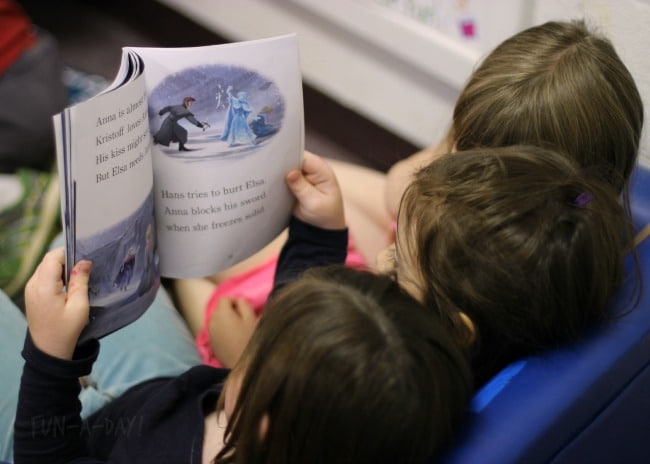
The children also learn some aspects of time management. Depending on your preschool schedule, centers could last an hour or more. While that’s a lot of time, it’s not infinite. At times, you’ll find your students will become upset at missing out on a center or two (because they’ve chosen to spend all of their time elsewhere). This will lead to some good discussions about priorities and allowing time for all of our interests.
I love observing my students during centers each year. It helps me to see what interests them the most, and it helps me plan the next phase of their learning. For example, one of my previous classes adored the building center, so I tried to capitalize on that interest in a variety of ways throughout the school year. Another group of kids went through a phase of intensive curiosity about bugs, so I brought more of my focus in to teaching about bugs. This helped engage the children even more in their preschool education in a fun, meaningful way.
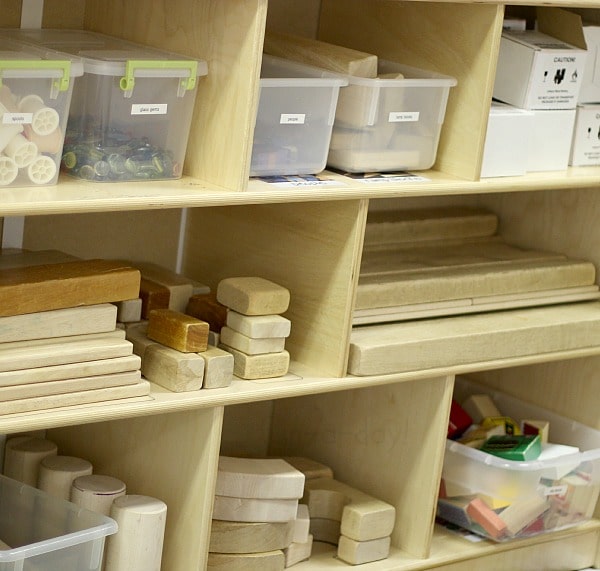
Related: Word Walls in Preschool and Kindergarten
Managing Free Choice Learning Centers in Preschool
I usually have a limit on how many kids can be at each center at any one time. The smaller areas, like the nature center in one of my old classrooms, are usually limited to 2 or 3 students.
Larger spaces, like the building center, can have 4 or 5. Sometimes I make exceptions, of course – if a larger group is super engaged in a project, I try not to break it up!
Here’s a tip for those centers that everyone wants to go to at the same time – use a sign up sheet. It doesn’t have to be anything special. A blank sheet of printer paper or construction paper on a clipboard, with a marker or pencil attached, and you’re good to go. And what a meaningful way for the children to practice writing their names!
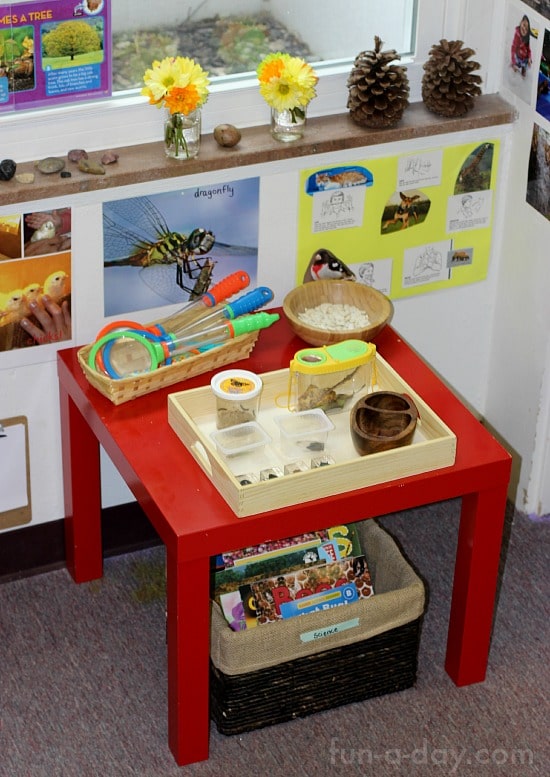
Throughout center time, I try to keep all areas of the classroom accessible to the children. Every once in a while, I close a center (usually to reorganize it or make room for a larger project). I let the children know it is off limits, and that’s that.
Below are the centers I usually have available:
- Reading and quiet time
- Writing
- Art and crafts
- Math and fine motor
- Building
- Home and pretend play
- Nature and science
- Sensory play
- On-my-own
Other Ideas for Using Free Choice Learning Centers in Preschool
With my preschool children, I’ve always been happy with how I managed free choice centers. I specified how many kids could be in a center at once, and then I oversaw the flow of children every day during center time. I taught the children what to do in the individual centers, and we practiced (a lot!) until things were running well.
Not all teachers prefer this rather wide-open way of keeping tabs on free choice centers, and that’s okay. I think it has to do with teacher preference, what your school administration would like to see, and the group of kids you have at any one time.
Here are a few other ideas to help free choice centers run smoothly in your preschool classroom. As with my way of managing learning centers in preschool, these ideas also need to be taught, modeled, and practiced with the children:
- Have a center chart with center cards that show each available center. Make sure to specify how many kids can be in each center at any time. Kids can place their names, photos, or clothespins next to the centers they’re using.
- Make a set of center necklaces, and hang these necklaces near each individual center area. For example, if four kids can be in the reading center, make sure to have 4 reading center necklaces. Children walk up to the centers and check to see if there is a necklace available. If there is, they can put the necklace on and join the center.
- If you’d rather not use necklaces, color-coded clothespins would work well as an alternative.
Learning Centers in Your Classroom
Please keep in mind that free choice centers may not work in every early childhood classroom. I really do think they’re the way to go when it comes to managing preschool centers. However, I liked using more structured center management when I taught kindergarten. If a more structured center time is needed in preschool, there are always ways to adapt them to include a lot of student choice. Remember that you, as the teacher, know what works best for your students and your school!
So, what do your learning centers in preschool look like? I’d love to hear what happens in YOUR classroom!
Amazing Resource for Your Early Childhood Centers
I’ve had many readers looking for help with centers, as well as requests for center cards – which led to the creation of this centers pack. If you’d like all the whys, hows, and to-dos in one place, along with a ton of printable center cards and signs, you need to check out this Preschool Centers Resource. Keep in mind, this would work great in other early childhood classrooms too! Below the photo you’ll see what comes in the 250+ page pack.
What’s Included
50 page planning guide
This teacher guide delves into what centers are, why they’re important, ideas for managing centers, how to set up centers in preschool, ideas for stocking centers, and how to introduce them to your students.
This planning guide would be great to print out and add to a teacher binder, or get them printed and bound separately to keep for reference in the classroom.
Printables for managing and labeling centers
There are a wide variety of centers included in these printables. This way, you can pick and choose what you need for your own classroom each year.
Here are the printables included along with the teacher guide:
- Large Center Signs
- Square Center Cards
- Center Choices Checklists
- Center Rules (with an editable option)
- Large Centers Signs (with room for students to add Name Cards)
- Editable Student Name Cards
- Center Sign Up Sheets
- “Work in Progress” Signs
- “Book Hospital” Labels
Get your Centers Guide on Preschool Teacher 101
Also available on Teachers Pay Teachers
Centers Materials
Letting the children have free choice during centers can sometimes be chaotic. Combat that chaos by keeping your enters organized. Here are some of the storage products that I find most helpful (I may get commissions for purchases made through links in this post):
The list includes just a few of my own preferences. Find the products that work best for you and invest in them. Staying organized helps keep me calm during the school days. I think it will help you, too!
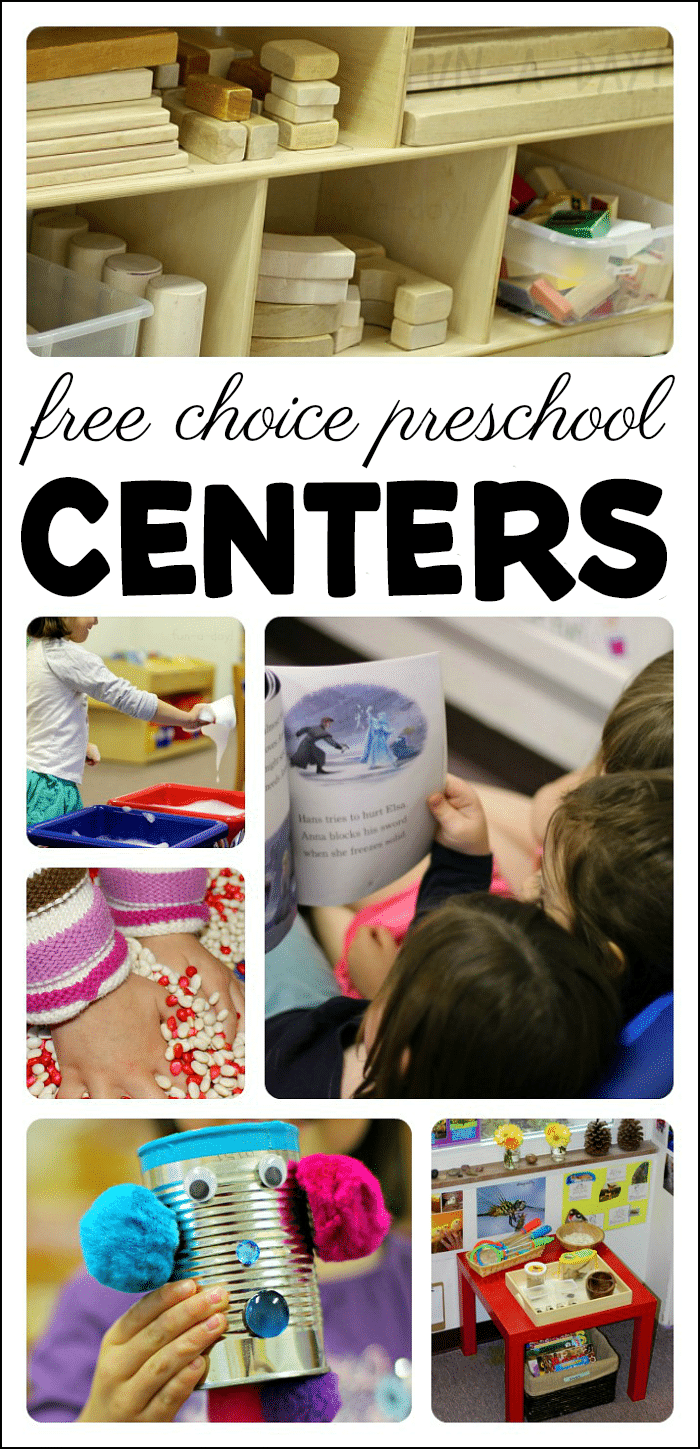
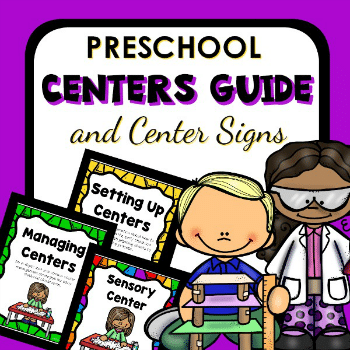
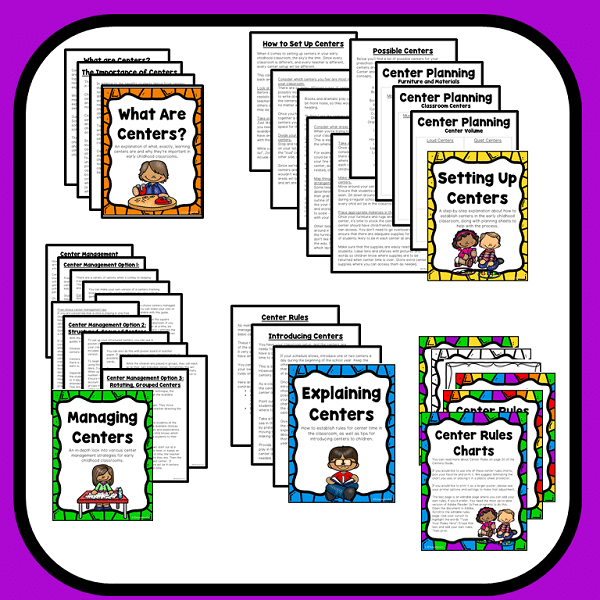
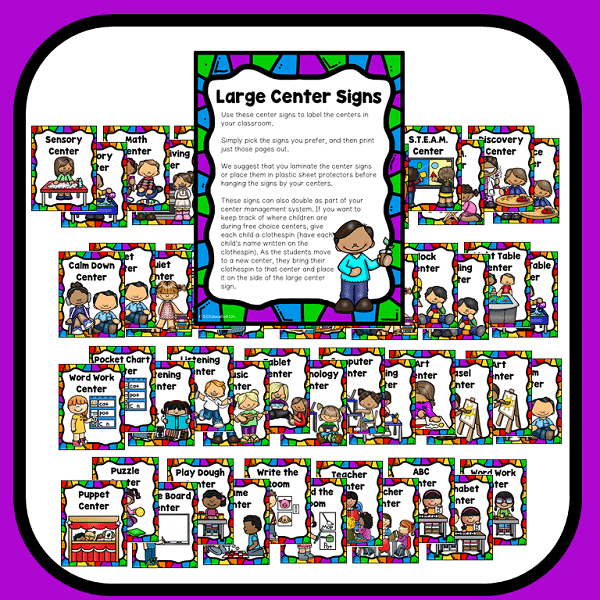
I do free choice centers as well. We’re actually required to in the Georgia Pre-K program, but this is what I’ve done for several years anyway. Years ago, I tried other ways, and it bothered some children to be directed to specific centers even for the first few minutes. I guess all children need some freedom and choices during part of their day.
I’m just starting centers and would like to do free choice. But I’m worried that if I don’t like it, it might be difficult to change over to directed centers. Then I think it might be better to be more structured at the end of the year in order to get them ready for kindergarten which is pretty structured in our school. Would love your comments on this. Thanks!
I have tried completely free choice in my classroom full of 3’s during center time, while calling a few children up at a time in order to work with them individually. Because I share my classroom with a church class, it is impossible for me to have specified centers set up at any given time, so I do the best I can with what I have! Because of their age, they had a very hard time regulating how many kids could be in a center, or good time management with free choice. While I dislike being controlling of what the children do, I had to gain some balance in my classroom. I decided to go to the can and “ticket” method. At the end of morning circle time, the children get to choose which station they go to. I usually have 3 red, 3 yellow, and 3 green tickets. I randomly choose a student one at a time to choose their ticket and station, but if you had a particularly rough circle time, chances are good you will be the last to choose your ticket. We usually have 2 teacher directed activities, and one area of free choice. The entire group must wait until their friends are done before they can rotate stations, that way they can learn patience and tolerance for their peers as well. It seems to work really well, and cut down on the chaos of the classroom.
Thanks for the information. I currently use free choice and love it! I was wondering how do you organize how the children pick their center and let other children know that it is at max capacity? Thanks!
How can I get a downloaded copy of your center rotation cards? I have been looking around your site and can’t seem to find them (only pictures of them).
Thanks.
Hi Anna! I made those on my computer quite some time ago. I’m not sure if they survived when one of my computers died but I shall check. 🙂
Just wondered where you got the spaceman being used between words by your student in the writing station?
Here you go – http://www.reallygoodstuff.com/spaceman-deluxe-student-set/p/151977/ 🙂
I am a bilingual pre-school teacher and I highly agree with your ideas! I love free choice open-ended activities for my preschoolers! I’m glad I open your blog! Would like to read more of your ideas! Thank-you!
Thanks so much for your input, Lucinda!
I use directed and non-directed centers most days in my preschool class (4-5 yrs) and the students seem to enjoy the balance. On Fridays we have a few bonus centers that they don’t have Monday-Thursday.
In the beginning of the school year it’s a bit crazy because they haven’t come from a three’s class of centers in our school. After a few weeks it gets easier and easier. By now, week eight, they understand the concept of centers, however the concept of using inside voices or whispers is a bit more difficult depending on the dynamics of the classroom. If anyone has any ideas about reigning-in the loud and constant talkers, I would be appreciative!
Thanks so much for sharing what works for you Tammy! Oh yes, working on those inside voices takes some time. My suggestion is a ton of modeling and a lot of pointing out when the volume is at a great level. Silly games that work on volume modulation are also a big help.